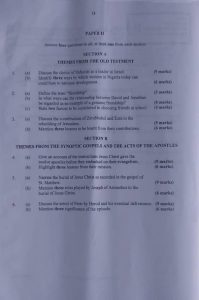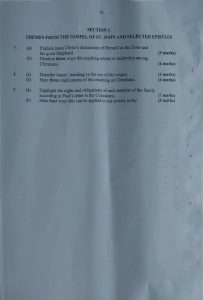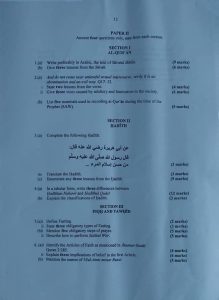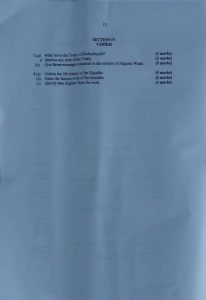Free and 100% Verified Solutions for 2025 NECO CRS/IRS OBJ/Essay Questions and Answers. If you are preparing for the NECO 2025 Christian Religious Studies (CRS/IRS) exams, you can find the verified solutions for these subjects below. The exams will commence on the 23rd of July, 2025

About NECO
The National Examinations Council (NECO) is a Nigerian examination body responsible for conducting and administering national examinations at the secondary school level. NECO plays a crucial role in assessing and certifying students’ academic achievements across various subjects.
Exam Overview
The NECO 2025 Christian Religious Studies (CRS/IRS) exams will assess students’ understanding of religious concepts, principles, and their ability to apply this knowledge to solve problems. These exams include both theoretical questions and practical applications, requiring a solid grasp of topics like scripture, ethics, and religious history.
Our Commitment
We understand how challenging these religious concepts can be. You don’t need to worry we’re here to make everything easier for you, including providing the answers.
This is to inform the general public and all students writing the exams, especially those in the religious studies field, that the CHRISTIAN RELIGIOUS STUDIES (CRS/IRS) EXPO answers are ready with us. We have ensured that the answers align with the marking scheme.
NECO 2025 CRS/IRS((Obj & Essay) Questions And Answers
Keep refreshing this page for the latest updates and invite others to join.
CRS QUESTIONS ESSAY QUESTIONS 2025


NECO IRS ESSAY QUESTIONS 2025


CLICK HERE TO GET FULL QUESTIONS AND ANSWERS
NECO 2025 CRS/IRS ANSWERS
2025 NECO Christian Religious Studies (CRS/IRS) answers are loading… Keep refreshing this page.
The Christian Religious Studies (CRS/IRS) 2025 exam answers will be uploaded for free here. All you need to do now is to keep refreshing this page and invite others to do the same.
2025 NECO CHRISTIAN RELIGIOUS STUDIES OBJ –Past
1-10: BDBADCECCE
11-20: CDAABCADAA
21-30: CDCCCDACEB
31-40: EBEEADCCCE
41-50: CEACCCACAD
51-60: ADBCDCECDA
COMPLETED!!!
NECO CRS /IRS ESSAY Answers –– past
CHRISTIAN RELIGIOUS STUDIES ESSAY
NUMBER 1
(1a)
Deborah’s emergence as a leader in Israel was a result of her exceptional spiritual gifts, personal qualities, and divine appointment. As a prophetess, she was attuned to God’s voice, receiving guidance and wisdom that resonated with her people. Her faith, obedience, and willingness to act on God’s instructions, even in the face of challenge and uncertainty, demonstrated her surrender to His will. This surrender led to a remarkable victory over the Canaanites, solidifying her position as a trusted leader and judge in Israel. Her leadership, marked by wisdom, courage, and discernment, brought a season of peace and prosperity to the nation, leaving a lasting legacy in the annals of Israel’s history.
(1b)
(PICK ANY THREE)
(i) Education and Mentorship: By pursuing higher education and professional development, women can take on roles as educators, mentors, and advocates for girls’ education. Educated women can inspire and guide the next generation, promoting a culture of learning and empowerment.
(ii) Entrepreneurship and Business: Women can contribute to the economy by starting and running businesses. Female entrepreneurs create jobs, drive innovation, and contribute to economic growth. Access to microfinance and business training programs can further support women in this area.
(iii) Political Participation: Women can engage in politics and governance, advocating for policies that promote gender equality, social justice, and economic development. By holding political office and participating in decision-making processes, women can ensure that diverse perspectives are represented in national policies.
(iv) Healthcare and Community Services: Women can play vital roles in the healthcare sector as doctors, nurses, midwives, and community health workers. By improving healthcare services and promoting public health initiatives, women can enhance the overall well-being of their communities.
(v) Advocacy and Activism: Women can lead and participate in advocacy and activism to address social issues such as gender-based violence, human rights, and environmental sustainability. Through non-governmental organizations (NGOs) and grassroots movements, women can drive social change and influence public policy.
(vi) Science and Technology: Women can contribute to national development by pursuing careers in science, technology, engineering, and mathematics (STEM). By breaking barriers in traditionally male-dominated fields, women can drive innovation, contribute to scientific research, and participate in technological advancements that propel national development.
…
====================
NUMBER 2
(2a)
Friendship is a close and mutual relationship between two or more people characterized by trust, affection, and support. It involves a bond where individuals care for each other’s well-being, share common interests, experiences, and emotions, and often provide emotional and practical assistance. Friendship is built on mutual respect, understanding, and a shared sense of companionship.
(2b)
(i) Selflessness and Sacrifice: Jonathan, despite being the son of King Saul and the heir to the throne, showed remarkable selflessness by recognizing David’s future as king and supporting him. He gave David his robe, armor, sword, bow, and belt as a sign of his loyalty and friendship (1 Samuel 18:3-4).
(ii) Loyalty and Support: Jonathan remained loyal to David even when his father, King Saul, sought to kill David out of jealousy. Jonathan risked his own life to protect David, warning him of Saul’s intentions and helping him to escape (1 Samuel 19:1-3; 1 Samuel 20:16-42).
(iii) Emotional Bond: Their friendship was deeply emotional. When they parted ways, they wept together, showing the depth of their bond and affection for each other (1 Samuel 20:41-42).
(v) Commitment and Covenant: Jonathan and David made a covenant of friendship before God, committing themselves to each other’s well-being and the well-being of their descendants (1 Samuel 18:3; 1 Samuel 20:12-17).
(vi) Respect and Honoring Each Other: Even after Jonathan’s death, David honored their friendship by caring for Jonathan’s son, Mephibosheth, showing that his commitment to their friendship extended beyond Jonathan’s life (2 Samuel 9:1-13).
(2c)
(CHOOSE ANY TWO)
(i) Shared Values and Interests: Look for friends who share similar values, beliefs, and interests. This common ground can help build a strong foundation for the friendship and make it easier to connect and engage in activities together.
(ii) Trustworthiness: Choose friends who are honest, reliable, and trustworthy. A good friend should be someone you can confide in and depend on, especially during challenging times.
(iii) Positive Influence: Consider friends who have a positive influence on you. Good friends should encourage you to do your best, make healthy choices, and stay out of trouble. Avoid friends who pressure you into negative behaviors.
(iv) Mutual Respect: Respect is a crucial component of any healthy relationship. Choose friends who respect your boundaries, opinions, and feelings, and who you can respect in return.
(v) Support and Empathy: Friends should be supportive and empathetic. They should be there to listen, offer help, and provide comfort when needed. Look for friends who show kindness and understanding towards you and others.
====================
NUMBER 5
(5a)
(PICK ANY ONE)
(i)
After Jesus’ crucifixion, His body remained on the cross until late afternoon. As evening approached, a wealthy man from Arimathea named Joseph, who had become a disciple of Jesus, went to Pilate to ask for Jesus’ body. Pilate, the Roman governor, granted Joseph’s request.
Joseph took down the body of Jesus, wrapped it in a clean linen cloth, and placed it in his own new tomb that he had cut out of rock. This tomb was located in a garden near the site of the crucifixion. After placing Jesus’ body in the tomb, Joseph rolled a large stone in front of the entrance to secure it.
Mary Magdalene and the other Mary were present, sitting opposite the tomb, witnessing where Jesus was laid.
The next day, the chief priests and the Pharisees went to Pilate. They expressed their concern, recalling that Jesus had said He would rise again after three days. They feared that His disciples might come and steal the body, then claim He had risen from the dead. To prevent this, they requested that Pilate order the tomb to be made secure until the third day.
Pilate agreed and told them to use a guard and secure the tomb as best as they could. So, they went and made the tomb secure by sealing the stone and setting a guard.
(ii)
In the Gospel of Matthew, after Jesus died on the cross, a wealthy man named Joseph of Arimathea asked Pilate for Jesus’ body. Joseph was a secret follower of Jesus and a respected member of the Jewish council. Pilate granted his request.
Joseph took Jesus’ body down from the cross, wrapped it in a clean linen cloth, and placed it in his own new tomb. This tomb was carved out of rock and had never been used before. Joseph rolled a large stone in front of the tomb’s entrance to seal it.
Two women, Mary Magdalene and the other Mary (mother of James and Joseph), witnessed the burial and sat opposite the tomb.
The next day, the chief priests and Pharisees went to Pilate. They reminded him that Jesus had said he would rise from the dead after three days. They asked Pilate to secure the tomb until the third day, so Jesus’ disciples couldn’t steal the body and claim he had risen. Pilate agreed and ordered the tomb to be sealed and guarded by soldiers.
(iii)
On the evening of Jesus’ death, a rich man from Arimathea arrived. His name was Joseph, and he was a disciple of Jesus. Joseph went to Pilate and asked for the body of Jesus. He took the body, wrapped it in a new linen sheet and placed it in his own tomb, which he had just recently dug out of solid rock. Then he rolled a large stone across the entrance and went away. Mary Magdalene and the other Mary were sitting there, facing the tomb.
(5b)
(PICK ANY THREE)
(i) Requesting Jesus’ Body: Joseph approached Pilate, the Roman governor, to request permission to take Jesus’ body down from the cross. This was a bold move, as it publicly aligned him with Jesus, who had been condemned and executed as a criminal.
(ii) Providing the Tomb: Joseph owned a new tomb that he had cut out of rock, and he offered this tomb for Jesus’ burial. This act of generosity ensured that Jesus had a dignified burial place.
(iii) Preparing the Body: After receiving permission from Pilate, Joseph took Jesus’ body down from the cross and wrapped it in a clean linen cloth. This preparation was a significant part of Jewish burial customs, ensuring that Jesus’ body was treated with respect.
(iv) Placing the Body in the Tomb: Joseph placed Jesus’ body in his own tomb, which was located in a garden near the crucifixion site. This act of placing Jesus in the tomb was a fulfillment of his role in ensuring Jesus received a proper burial.
(v) Sealing the Tomb: Joseph rolled a large stone in front of the entrance to the tomb. This act of sealing the tomb helped secure it and marked the completion of the burial process.
NUMBER 6
(6a)
Herod Agrippa I, seeking to suppress the early Christian movement and gain favor with the Jewish leaders, began persecuting the church. After executing James, he saw the positive response and arrested Peter during the Feast of Unleavened Bread. Herod planned to publicly try and execute Peter after Passover. To prevent any escape, Peter was heavily guarded by four squads of soldiers, with two chains binding him and guards positioned both inside and outside the prison.
While Peter was imprisoned, the church fervently prayed for his deliverance. On the night before Peter’s trial, an angel of the Lord appeared in his cell. A light shone, and the angel woke Peter, instructing him to get up quickly. The chains fell off Peter’s wrists. The angel guided Peter past the guards and out of the prison, with the iron gate opening by itself. Once outside, the angel left him, and Peter realized he had been miraculously freed.
Peter went to the house of Mary, the mother of John Mark, where believers were praying. A servant girl, Rhoda, answered Peter’s knock but, in her excitement, forgot to open the door and ran to tell the others. Initially, they did not believe her, thinking she was mistaken. However, when they finally opened the door, they were astonished to see Peter. He explained how the Lord had delivered him and instructed them to inform James and the other brothers before leaving for another place.
The next morning, there was great confusion among the soldiers about Peter’s disappearance. Herod, unable to find Peter, ordered an extensive search. When Peter remained unfound, Herod interrogated the guards and ordered their execution, reflecting the severe consequences for failing to secure a prisoner.
(6b)
(PICK ANY THREE)
(i) Power of Prayer: The episode underscores the effectiveness and power of collective prayer, as the church’s fervent prayers were instrumental in Peter’s miraculous deliverance.
(ii) Divine Intervention: It highlights God’s active involvement and intervention in the lives of believers, showcasing His ability to deliver and protect His followers in seemingly impossible situations.
(iii) Strengthening Faith: The miraculous escape of Peter strengthened the faith of the early Christian community, providing them with renewed courage and confidence in God’s providence.
(iv) Witness to Non-believers: The incident served as a powerful testimony to both believers and non-believers, demonstrating the reality and power of the Christian God, which could lead others to faith.
(v) God’s Sovereignty: It emphasizes God’s sovereignty over human plans and authorities. Despite Herod’s intentions, God’s plan prevailed, and Peter was freed, showing that divine will supersedes human actions.
(vi) Encouragement in Persecution: The deliverance of Peter provided encouragement and hope to the early Christians, reassuring them that God was with them even in times of severe persecution and adversity.
See Also:
- NECO 2025 Igbo, Yoruba, Hausa OBJ/Essay Questions and Answers
- 2025 NECO Financial Accounting Expo/Runs (Obj/Essay) Questions
Feel free to share this with your peers and anyone else preparing for these exams. Good luck with your studies!
